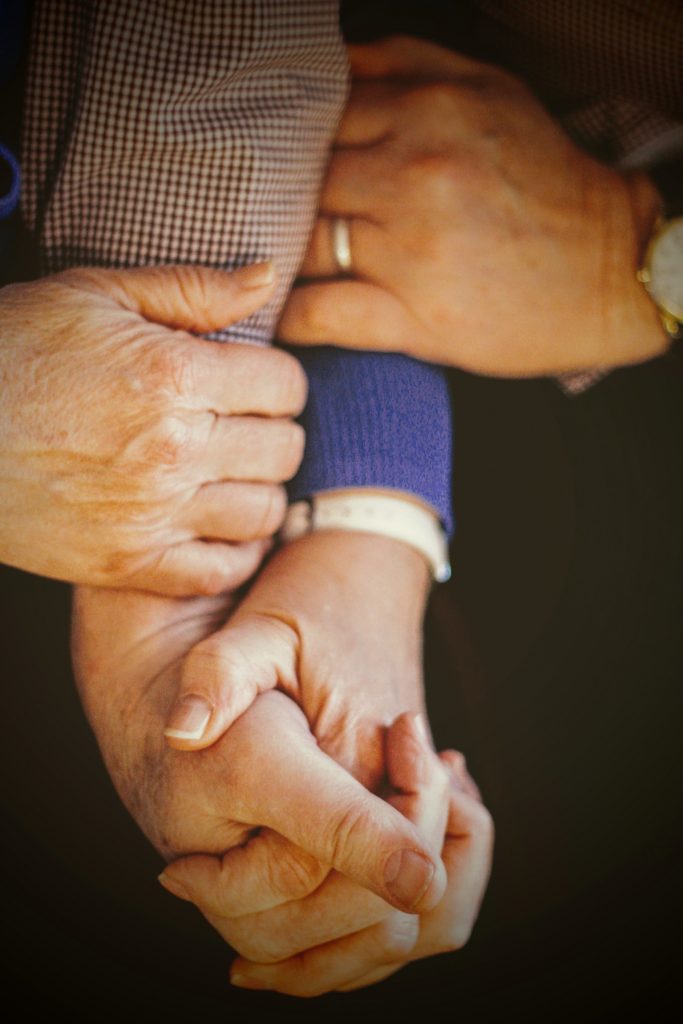s
Common Questions about VSED
s
What is VSED?
VSED stands for Voluntarily Stopping Eating & Drinking, and is also sometimes known as terminal or end-of-life fasting. Many people lose their appetites at the end of their lives and stop eating as their body’s organs shut down. Others deliberately choose to stop eating and drinking in order to hasten their death. This end-of-life choice is known as VSED.
Who is most likely to use VSED?
People with certain diseases—especially degenerative diseases like Alzheimer’s, ALS, and MS—do not qualify for hospice care or Washington State’s Death with Dignity (DWD) law.* Because of their suffering, VSED may be the only option for them to maintain autonomy at the end of their life.
*Washington State’s Death with Dignity law requires that a person be mentally competent and have received a terminal diagnosis with a six-month prognosis in order to make the decision to end their life. Because of these requirements, people with dementia or another diagnosis without a six-month prognosis do not qualify for DWD. However, as long as a person is mentally competent (i.e., physically ill or in the early stages of dementia), they can legally choose to end their life using VSED.

What are the requirements?
VSED requires commitment, will power, and resolve. Talk with a healthcare provider ahead of time about your end-of-life options. If you determine VSED is the right choice for you, talk with your family about your decision so that you have the support you need. Identify caregivers who are not family; this allows family members to be emotional supports rather than caregivers. Read up on what happens during the VSED process. Having a clear understanding of what to expect is critical in maintaining the determination to complete VSED. Lastly, be sure to get your legal and financial paperwork in order before you begin fasting.
If I want to VSED, what should I do next?
- Talk with a medical provider about your interest or decision and ask if they can help you with VSED; if they are unable to support your VSED process, ask them to refer you to someone who can
- Talk with family members about your decision; determine if they can help with emotional support and finding experienced caregivers
- Get your legal and financial affairs in order
- Make plans for what will happen to your body after death
Legal and Practical Considerations
Is VSED legal?
Yes! Patients have the right to refuse care, including food and hydration. However, it is helpful to consult an attorney who can help you organize your legal and financial affairs before you begin.
What is the cost for VSED?
- Medication: Cost of palliative care medications is minimal. On average, people who VSED can expect to spend less than $100 on pain relievers, anti-anxiety medication, and other palliative care medications.
- Medical supplies: If you decide to VSED at home, you will need to rent a hospital bed and bedside commode. You may also need to purchase a humidifier and other supplies, like lotion, mouth care items, and incontinence products. Again, these costs vary.
- Hired caregivers: The out-of-pocket cost of caregivers experienced with end-of-life care varies depending on how many hours per day they are needed and how long the VSED process takes. Average costs can range anywhere from several hundred dollars to a few thousand dollars. Proper caregiver support is essential for VSED. Hired caregivers provide personal care, give medications as necessary, and release family members from caregiving responsibilities. VSED can take anywhere from several days to 2-3 weeks, and it’s critical for family members to eat regularly and get adequate sleep during this time.
- Death doula: A death doula helps families coordinate with caregivers, hospice, outside healthcare providers, and community services. They teach family members about the dying process and promote a calm environment by helping decrease stress and conflict. Costs associated with hiring a death doula vary by region and practitioner.
- Hospice: If you qualify for Hospice Care, costs for some medical items are at least partially covered by Medicare. However, hourly or daily caregiver expenses are not covered by hospice.
Is VSED covered by medical insurance?
No, not typically. Medication is covered if you have Medicare or pharmacy coverage. Caregiving, however, is not unless you have Long-Term Care insurance.
Does dying by VSED affect life insurance payments?
No. Voluntarily stopping eating and drinking (VSED) is not considered suicide.
What is listed as cause of death on the death certificate?
The underlying disease process is listed as the cause of death. If you qualify for hospice care, your hospice organization will take care of the death certificate.
The VSED Support Team
Who helps me through the VSED process?
While the support team varies depending on the individual, medical and emotional support is critical to a successful VSED process. It is important to become knowledgeable about VSED by speaking with your medical care provider and, if possible, a caregiver or other person who has witnessed someone dying via VSED.
We also recommend working with a death doula, an end-of-life professional who serves as a compassionate case manager. The death doula helps the whole family understand what happens during VSED, coordinates schedules and caregiving responsibilities, helps family members determine how they can be supportive, communicates with healthcare providers and hospice staff, helps the person and family anticipate the daily changes, and coordinates after-death plans.

Will my doctor help me VSED?
Some doctors and physician assistants can medically manage VSED if they choose. Providers associated with Catholic hospitals are sometimes prohibited from doing so. It is important to speak with your own healthcare provider. If they cannot assist you, ask to be referred to someone who can help.
Can I VSED at home?
Yes, VSED can take place at home; that’s where most people prefer to be at the end of their lives. Other arrangements can also be made.
Do my family members need to agree with my decision?
No, but it’s helpful if family members are on board. Family and friends provide important emotional support during the VSED process. That’s why it’s important to have a “courageous conversation” with family to tell them of your decision to VSED.
Is VSED part of hospice care?
VSED often is part of hospice care, especially if the person receives those services at home. Some hospice care facilities do not allow their residents to use VSED on site. Federal regulations mandate that people have a diagnosis of six months or less to live in order to qualify for hospice. While some people who choose to use VSED have that diagnosis, others do not. Some hospice providers now consider a person eligible for hospice care BECAUSE they intend to VSED, which, of course, would cause them to have fewer than six months to live.
It’s important to check with your local hospice program provider ahead of time about whether you qualify for services. If you do not qualify for hospice prior to starting VSED, you might be able to qualify once you have started the process or when you become unconscious. A death doula can be helpful in sorting out when and if you qualify for hospice care and/or may complete your VSED process in a care facility.
If I qualify for hospice, does hospice replace the caregivers I have hired to help me VSED at home?
No. Hospice offers access to a registered nurse, social worker, bath aide, chaplain, and other palliative care services, but they do not provide daily or hourly caregivers.
The VSED Process
How long does it take?
On average, VSED takes around 10 days, but it can take shorter or longer depending on the health status of the person doing VSED. If there is a disease process involved, the time to death may require fewer days, while for those who are not terminally ill, it is often 10 days or longer.
What steps are involved?
The VSED preparation process starts with an initial clearing of the gut, similar to the preparation for a colonoscopy. Clearing the intestines and colon of food helps prevent constipation and abdominal pain later. After this cleanse, no food or water is ingested. Caregivers pay careful attention thereafter to the patient’s comfort, safety, and physical and emotional support. Bodies can live without food but not without water. If neither food nor water is ingested, the body’s organ systems begin to shut down within the first week, and the person enters a coma a few days before death.

What medications are involved in the VSED process?
Healthcare providers can write prescriptions for liquid morphine and lorazepam, medications that can lower anxiety and help ease difficulty in breathing—two common symptoms people experience as their body organs shut down during the VSED process. For those with dementia, haloperidol may treat delirium, agitation, and severe sundowning associated with physical and cognitive decline during VSED.
What does the VSED process feel like?
VSED is not associated with any unique end-of-life symptoms. Pain, dry mouth, thirst, shortness of breath, and agitation are commonly reported, but these can be minimized with proper medical support. Hunger is not common during VSED.
Symptom management is the same as with other dying patients:
- Feelings of thirst are lessened with careful mouth care, i.e. brushed teeth, lip balm, occasional spritzing with fine mist of water, cool cloths to the face
- Dry mouth and throat are helped with using a cool air humidifier in the room
- Dry skin soothed with lotion and cool, wet cloths
- Shortness of breath and anxiety are lessened with liquid morphine and lorazepam.
During the initial few days of the process, an individual can interact almost normally with family members, and may take pleasure in hearing family stories, listening to favorite music, or being read to. This is a precious, sacred time for doing the work of dying: saying goodbye, forgiving and being forgiven, and expressing love.
How can I find out more?
Our Reading List page contains additional resources, from books and videos to articles and podcasts. You may also call us at (360) 919-6363 or email us at info@VSEDresources.com to set up an initial consultation.
